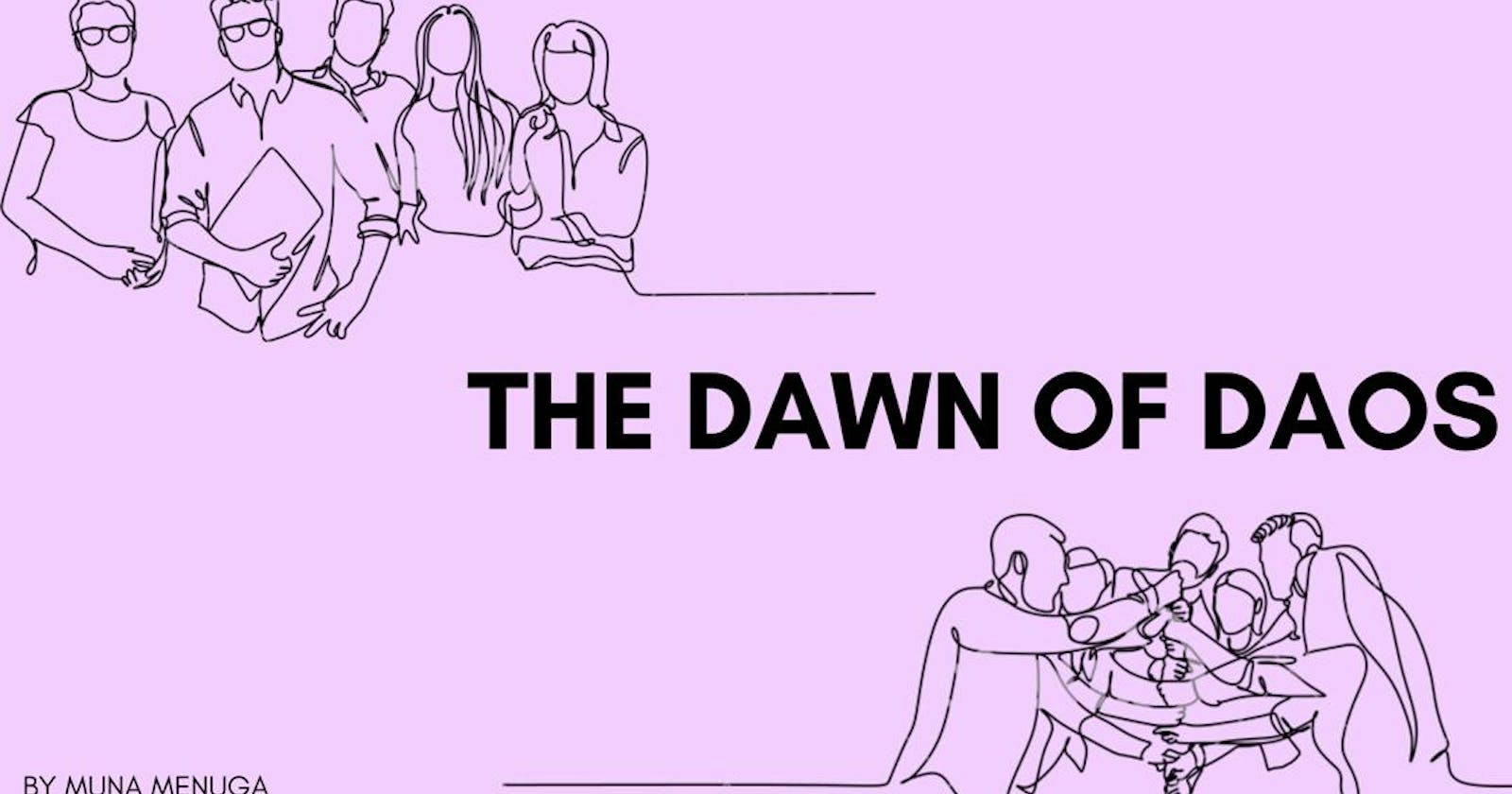DAOs - love ‘em or hate ‘em?
Web3 has so far been the most polarizing trends in tech history. First with cryptocurrencies, then NFTs and now DAOs.
These trends bring out different types of emotions from a large number of people. Some people love them, some people don’t like them and other folks just don’t understand them.
I was recently listening to a very popular UK-based business podcast and when asked of their opinion on the topic of DAOs and their impact in Web3 and the overarching tech ecosystem, the guest replied saying "Not everyone should have a say".
Before I ask YOU how you feel about the next fast-rising pillar in Web3, I wanna be sure that you fully understand what DAOs are about (Pretty sure the podcast's guest didn't).
This is why in today's article, I am going to be giving you a full breakdown of what DAOs are and the why behind them.
But before we get into the nitty gritty about the state of DAOs, let’s go over the basics.
DAO - Acronym for “Decentralized Autonomous Organization” which refers to an organization that is run by computer programs called smart contracts. The details of this smart contract are agreed upon by the members of the DAO. There is no central authority within a DAO. It functions on the collective effort of all the members involved.
Smart Contracts - A piece of code that is programmed to perform tasks within the organization like implementing decisions. The use of smart contracts allows a DAO to be autonomous and self-sustaining.
DAO Tooling - This is a process of using Web3 based tools to manage incentives, maintain relationships between every member of an organization and to design the infrastructure that a community would grow on.
Before you mistake a DAO for a social club or online group chat, DAOs are basically changing the traditional idea of operations within veteran companies, startups and organizations. However, when compared to other pillars which have grown DeFi (Decentralized Finance) from $7.3B to over $90B in the past year, it’s safe to say that DAOs are still in their foundational stages.
What are DAOs used for?
A DAO can be used for a variety of purposes/goals which can include anything ranging from,
Building products
Investing in projects
Providing services and
Collecting NFTs and other collectibles.
Many DAOs are used to fund, accelerate and promote several causes across several niches like tech, education and even medicine. But today's article won't be focused on the utility of DAOs but instead on how they work internally to achieve their goals and how you fit into the grand plan. This brings us to the question "How are DAOs organized".
How a DAO is set up.
Unlike a traditional organization where employees are recruited in their numbers, a DAO usually starts with a meagre headcount, as small as 2-10 people. The small group goes on to break into different sub-groups depending on function and the interest of the members as the size increases.
The members of each sub-group then take full responsibility for a particular milestone that contributes to the overall goal of a chosen project.
That's the important part because that's where you come in. Depending on your background or expertise, you can take responsibility for any sub-task that you feel confident enough to contribute to. Your participation will allow you to fall into a core group of members with similar tasks/responsibilities.
The title for each group is different depending on the specific DAO but they all serve basic operational functions. These 7 pillars are easily recognizable across any DAO,
- Community
- Marketing/PR
- Product
- Engineering
- Treasury
- Business Development
- People
In certain DAOs, working group leaders can be nominated and elected as well as voted out by the community.
Sound familiar? I bet it does.
What makes a DAO unique?
The main difference between a DAO and your favorite company is the fact that the opportunity to contribute to any of the roles are open. Major decisions aren’t made behind closed doors and in a board room full of selected central authorities. Anyone can make a decision, create a new working group, make a new proposal and even change the state of running things.
A DAO also offers a unique value proposition thanks to this difference. All the major components of a DAO including its purpose, performance metrics, resources and actual results are transparent to its members. This encourages a wider community and creates transparency and accountability.
Side Note: Don't be like the ignorant Podcast guest who assumed that because everyone had a say in the affairs of a DAO, it would be chaotic. Decentralization ≠ leaderless. Quite the contrary, members of a DAO are led and united by a common purpose which empowers them to work collaboratively towards accomplishing said goal.
#The Secret Road A Contributor earns the title of a contributor when they have graduated from lurking on social media, being passive in Discord and making surface-level connections with other members. Once they have reached the point of meaningful interest backed by action, then they are crowned a Contributor. They now have a strong sense of ownership, belonging and responsibility to the DAO.
Fun Fact: I am a member of a number of DAOs but I am a contributor for WomenBuildWeb3 (WBW3) DAO. Twitter: Women Build Web3
A DAO manages the growth of its contributors in three main ways:
Bounties: These are little tasks which are compensated that interested members of a DAO can work on and complete in order to mark their position in the DAO. It is usually the first step for onboarding new contributors because it provides them with the scope and deliverables of frequent projects in the DAO. Interested members can also find bounties using tools like Dework or Rabbit Hole or it can be verified by the owner of the bounty using tools like Coinvise or Gitcoin.
Identity: Contributing members of a DAO have a separate identity from other members that signals their growing reputation. This identity is usually represented using a "Discord Role/Title". These badges/titles help to establish trust and build a bridge between old and new DAO members.
Reputation: This is probably the most beneficial growth trajectory for a DAO member. This helps establish the identity of certain contributors to potential members, recruiters, future partners, sponsors or connections in the social scene. DAO-based affiliations are very pluralistic in nature because it helps establish the identity of a contributing member across several communities in the Web3/Tech ecosystem. It serves as the embodiment of the contributor's work ethic, passion and motivation.
FINALLY,
Clearly, DAOs bring a new and important element to Web3 which was only touched by DeFi and NFTs. It encourages the element of community and fosters genuine innovation through cooperation.
No doubt, there are a lot of mind-blowing DAOs who are really changing the space right now and are using Web3 tools to push out interesting products but I'll reserve their identities for another article (stay tuned ;).
If you are trying to understand Web3 in general, I suggest you check out a DAO. Not only would it expand your network, but it will accelerate your learning process.
Are you a part of a DAO? If yes, which one? If you're interested in joining a DAO, let me know in the comments below. Who knows, I might write about a DAO suitable for you in the next article.

